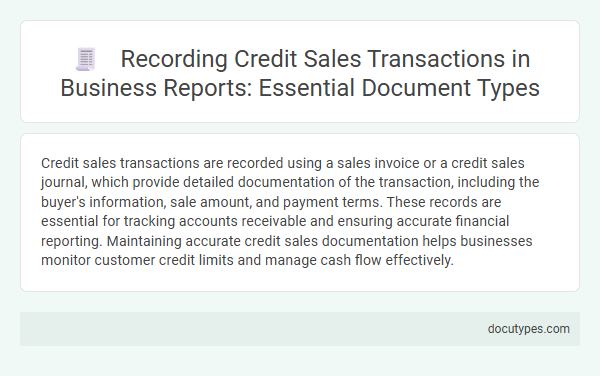Credit sales transactions are recorded using a sales invoice or a credit sales journal, which provide detailed documentation of the transaction, including the buyer's information, sale amount, and payment terms. These records are essential for tracking accounts receivable and ensuring accurate financial reporting. Maintaining accurate credit sales documentation helps businesses monitor customer credit limits and manage cash flow effectively.
Introduction to Recording Credit Sales Transactions
Recording credit sales transactions is essential for accurate financial management and maintaining clear customer accounts. Understanding the primary document used in this process helps ensure your accounting records are precise and reliable.
- Sales Invoice - This document records the details of goods or services sold on credit to a customer.
- Accounts Receivable Ledger - It tracks all credit sales transactions and outstanding customer balances.
- General Journal Entry - Used to formally record credit sales into the company's accounting system for financial reporting.
Importance of Accurate Documentation
The document used to record credit sales transactions is typically a sales invoice. This document details the products or services sold, the amount owed, and the payment terms.
Accurate documentation of credit sales transactions ensures clear communication between the seller and buyer. It serves as a legal record for both parties, supporting financial tracking and audit processes. Your business relies on precise invoices to maintain trust and streamline accounts receivable management.
Key Document Types in Credit Sales
Credit sales transactions require specific documentation to ensure accurate financial records and facilitate customer accounts management. Proper use of these key documents helps maintain clarity and accountability in credit sales processes.
- Sales Invoice - A primary document issued to the buyer detailing the products or services sold on credit, including quantities, prices, and payment terms.
- Credit Memo - Used to record any adjustments or returns related to credit sales, reflecting reductions in the amount owed by the customer.
- Sales Journal - A specialized ledger that records all credit sales transactions systematically for accounting and auditing purposes.
Sales Invoice: Structure and Significance
| Sales Invoice: Structure and Significance in Recording Credit Sales Transactions | |
|---|---|
| Document Used | Sales Invoice |
| Purpose | Records detailed information about credit sales, serves as a legal proof of transaction, and facilitates accounts receivable tracking. |
| Key Components |
|
| Significance | The sales invoice is essential for maintaining accurate financial records, managing your accounts receivable efficiently, and ensuring transparency in business transactions. It supports auditing processes and helps in dispute resolution by clearly detailing what was sold on credit. |
Delivery Note and Acknowledgment
The primary document used to record credit sales transactions is the delivery note. This document serves as proof that goods have been dispatched to the customer under credit terms.
The delivery note includes essential details such as product descriptions, quantities, and delivery dates. An acknowledgment signed by the customer confirms receipt and acceptance of the goods.
Credit Note: Purpose and Format
What document is used to record credit sales transactions? A credit note is the primary document used to record credit sales transactions. It serves to adjust the amount owed by the buyer in case of returned goods or errors in the original invoice.
What is the purpose of a credit note? Your business issues a credit note to formally acknowledge the reduction in the amount receivable from a customer. This document helps in maintaining accurate accounting records and customer accounts.
What is the format of a credit note? The credit note typically includes the credit note number, date of issue, buyer's details, original invoice number, description of goods or services, quantity returned, and the adjusted amount. Clear formatting ensures transparency and ease in record-keeping.
Customer Statement of Account
The Customer Statement of Account is the primary document used to record credit sales transactions. It provides a detailed summary of all purchases, payments, and outstanding balances for a specific customer over a defined period.
This statement helps businesses track credit activity and ensures accurate accounting of receivables. It serves as both a record for the company and a communication tool to customers regarding their account status.
Recording Receipts and Payments
The primary document used to record credit sales transactions is the sales invoice. This invoice details the goods or services sold, the amount owed, and payment terms, serving as a formal acknowledgment of the credit sale. Recording receipts and payments involves matching these transactions with corresponding cash receipts or payment vouchers to ensure accurate financial tracking and reconciliation.
Internal Controls in Credit Sales Documentation
The primary document used to record credit sales transactions is the sales invoice, which details the products or services sold, the amount owed, and payment terms. Effective internal controls in credit sales documentation ensure accuracy, prevent fraud, and facilitate timely collection by verifying the legitimacy of each transaction. Your business benefits from implementing standardized invoice procedures and regular audits to maintain integrity in credit sales records.
What Document Is Used to Record Credit Sales Transactions? Infographic

